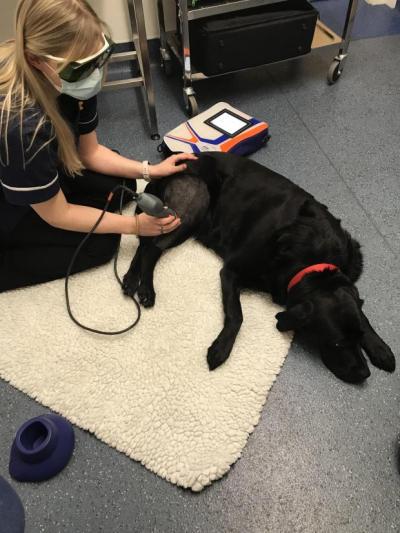
By Veterinary Nurse Donna Hall
Exercise programmes can make a huge difference to dogs which are suffering a loss of mobility, so I was over the moon to gain my Diploma in Canine Exercise Rehabilitation recently.
It is not very common for veterinary nurses to have this qualification and I believe it is not common in this area. The course took 14 months to complete and was very in-depth, but the hard work was worth it.

When I started my vet nurse training I was really interested in physiotherapy and four years ago I started running mobility clinics at Paragon. As I progressed, I wanted to be able to do more.
The diploma means I am qualified to actually prescribe a treatment with appropriate exercises to hopefully return them to full function. Exercise rehab can be helpful for orthopaedic and neurological patients as well as dogs which have received an injury, as can happen with athletic or working breeds, plus dogs with mobility problems.
After surgery it can help dogs to get their leg back to how it should be in terms of joint range of motion and muscle strength and does it in a way which is pain-free and avoids causing trauma or risking recurrence of the injury.
With cases of arthritis, I will typically prescribe the owners with basic physio exercises which will slow down its progression. The exercises can help with pain relief, keeping joints functioning, and muscle strengthening.
Each case is different, so each programme is tailored specifically for each dog. We can use massage techniques; different ones have different benefits. Range of motion exercises help joints to move through their full range, which keeps the joint nourished. These might include things like the dog moving from lying down to sit, or asking for a paw. Some are very basic and some can be developed into more complex exercises.

I recently worked with Mandy, a Labrador who had surgery for a ruptured cruciate ligament. After her op we did hot and cold packs and then treatments including passive range of motion stretches on her stifle joint and sit stand exercises to help build muscles.
She is not on any pain relief now and can walk 30 minutes at a time including little hills, which is fantastic to see. Previously she was obviously lame and couldn’t go for walks.
Exercise rehabilitation can work wonders. It is very rewarding when they come back and you think, Oh my goodness it looks like a different dog!